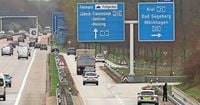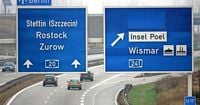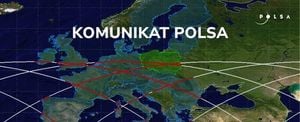On May 7, 2025, traffic congestion across various regions in Germany has become a pressing issue, as multiple areas report slower-than-usual travel times due to construction and accidents. The CZ-Staumelder, LN-Staumelder, OZ-Staumelder, and RGA-Staumelder have all provided updates on traffic conditions in their respective regions, highlighting the routes most affected by delays.
In Celle, the CZ-Staumelder has identified key bottlenecks on major roads such as Bundesstraße 3 (B3), which experiences heavy traffic towards Hannover and Soltau, and Bundesstraße 214 (B214), which is congested towards Braunschweig and Schwarmstedt. Another critical area is the Wilhelm-Heinichen-Ring in Celle, where ongoing construction work has caused significant delays. The data for these updates is sourced from TomTom, a navigation service that utilizes GPS data from millions of devices. According to their system, which is updated every five minutes, the information includes automatic data from around 80 million mobile devices and several million governmental road sensors, ensuring accuracy and timeliness.
Moving to Lübeck, the LN-Staumelder has reported similar conditions, particularly on the Autobahn 1 and Autobahn 7, which are notorious for traffic jams, especially during peak tourist seasons. The A1, which connects Hamburg to coastal towns, has been particularly affected, with delays reported frequently. Like Celle, Lübeck's traffic updates are also powered by TomTom's extensive data network, providing residents and travelers with real-time information about their routes.
In Wismar and Grevesmühlen, the OZ-Staumelder has indicated that the A14 and A20 are among the major highways experiencing slow traffic. The Wismar-Mitte junction, in particular, has become a hotspot for accidents, despite a speed limit of 60 km/h. This junction has seen numerous incidents due to turning and right-of-way errors, raising concerns among local authorities about road safety.
Meanwhile, in Remscheid, the RGA-Staumelder highlights the A1 and A46 as the most congested routes in North Rhine-Westphalia, with the A1 being one of the most congested highways in the country, racking up nearly 6,500 hours of traffic jams between Cologne and Dortmund. The A46, linking Düsseldorf and Wuppertal, is also noted as the sixth most congested route in the region. The local traffic updates emphasize the importance of the B229 and B237, which connect various towns and are critical for commuters. Drivers are urged to remain cautious, especially in areas prone to accidents.
Overall, the traffic situation across these regions serves as a reminder of the ongoing challenges faced by road users in Germany. With construction projects and increased vehicle numbers, the need for accurate and timely traffic information has never been more critical. As part of their commitment to public safety, authorities encourage all drivers to stay informed and patient during their travels, taking heed of the updates provided by services like TomTom.
In conclusion, the traffic congestion reported by the CZ-Staumelder, LN-Staumelder, OZ-Staumelder, and RGA-Staumelder highlights the significant impact of ongoing construction and accidents on travel times across various regions in Germany. With real-time data from TomTom, drivers can navigate these challenges more effectively, ensuring safer and more efficient journeys.





